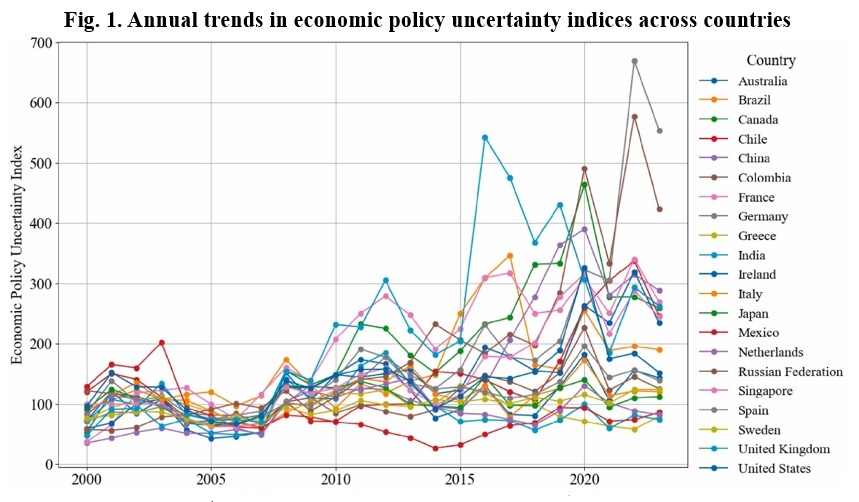Robots and Renewables Driving Economic Policy Stability*
9/15 2025
Author: Farhad Taghizadeh-Hesary
1. Introduction
Economic policy uncertainty (EPU) has become a central concern, shaped by global disruptions such as the Covid-19 pandemic, the Russia-Ukraine conflict, trade tensions, and the climate crisis. High uncertainty weakens sustainable growth, deters private and public investments, and complicates long-term planning. While the EPU index has advanced our ability to track such fluctuations, identifying strategies to reduce uncertainty remains a key policy challenge.

As shown in Fig. 1, the EPU indices in the 21 countries exhibit cyclical fluctuations, rising sharply during crises such as the 2008 financial crisis and the 2020 pandemic, and easing during recovery phases. These patterns underscore how shocks and policy shifts shape volatility.
Two strategic shifts offer potential solutions: the adoption of industrial robotics and the transition to clean energy. Robotics, increasingly promoted through public and private initiatives across advanced and emerging economies, is reshaping productivity and industrial resilience worldwide. At the same time, the energy transition, driven by ambitious renewable energy targets in regions such as the EU, Asia, and North America, is transforming economic structures on a global scale. However, their combined impact on policy stability remains underexplored.
This policy brief, extracted from Liu et al. (2025), in which the author of this brief was a coauthor, addresses three questions:
I. Do industrial robotics and energy transition reduce EPU?
II. Do their effects differ by countries’ human capital levels?
III. Do robotics and renewables interact to create additional stabilizing effects?
Using panel data from 21 countries (As in Fig.1) between 2000 and 2023, the study provides new evidence that both robotics adoption and clean energy use reduce policy uncertainty, with impacts varying by human capital. Importantly, their interaction generates a synergistic effect, underscoring the value of integrating technology and sustainability strategies to build more stable policy environments.
2. Empirical Results
This study empirically examines the impact of industrial robotics and energy transition on EPU. EPU serves as the dependent variable and is measured using the Economic Policy Uncertainty Index developed by Baker et al. (2016). The core independent variables are the stock of industrial robots across industries, aggregated at the country level, and the proportion of the population using clean fuels for cooking, which reflects a country’s energy policy commitment and public adoption of clean energy.
To address potential confounding factors, the model incorporates control variables that may influence EPU. Economic growth is captured by per capita GDP growth, as a higher economic development typically contributes to social and political stability. Industrial upgrading is represented by the share of employment in the tertiary sector, which can drive fluctuations in policy due to shifts in labor demand and lobbying for sector-specific regulations. Foreign direct investment (FDI) inflows are measured as a percentage of GDP. While inflows of FDI can generate investment and employment opportunities, they may also affect the host country's exchange rates and trade balance, potentially leading to fluctuations in economic policy. Population density is included to account for market size and resource demand, which may necessitate policy adjustments.
The empirical results show that both industrial robotics and the energy transition significantly reduce EPU. Robustness checks with alternative EPU measures and growth indicators confirm these outcomes. Heterogeneity analysis indicates that energy transition is more effective in countries with higher human capital, while industrial robotics plays a stronger role in mitigating EPU in countries with lower human capital. Moreover, interaction analysis reveals a synergistic effect between robotics and energy transition once endogeneity is addressed. Specifically, a 1% increase in industrial robot adoption reduces EPU by 0.035%, while greater reliance on clean energy leads to an even larger decline. These effects, however, differ depending on the level of human capital across countries.
3. Policy Implications
This study carries significant implications for policymakers, especially as countries face diverse demographic and economic challenges. For instance, Japan’s declining population highlights the importance of industrial robotics to sustain productivity, while high human capital economies can benefit more from accelerating the energy transition. In contrast, lower human capital countries may rely more heavily on robotics to reduce uncertainty and stabilize economic activity. The synergistic role of combining robotics with clean energy transition underscores the need for integrated policy approaches.
I. Promote Industrial Robotics Adoption
Governments should facilitate technological upgrading in enterprises through R&D subsidies, tax incentives, and industry–academia collaboration to boost productivity and reduce supply chain vulnerabilities.
II. Strengthen Labor Market Adaptation
In countries with strong human capital bases, vocational training and skill transition programs are essential to mitigate potential labor disruptions from automation while harnessing the benefits of robotics.
III. Accelerate Energy Transition
Policymakers unlock private sector investments in renewable infrastructure, improve accessibility and affordability of clean technologies, and ensure transparent, stable energy policies to curb uncertainties from volatile fossil fuel markets.
IV. Diversify Energy Sources
Encouraging a balanced energy mix strengthens system resilience and mitigates risks associated with external shocks or supply disruptions.
V. Integrate Industrial and Energy Policies
Coordinated initiatives that link robotics adoption with clean energy expansion can maximize efficiency, reduce reliance on external conditions, and further stabilize economic environments.
* This policy brief is based on the study published as Liu Y., Zhao C., Kong Z., Taghizadeh-Hesary F., (2025). Pathways to stable economic policy: The role of industrial robotics and energy transition, Renewable Energy, 244, 122751, https://doi.org/10.1016/j.renene.2025.122751
